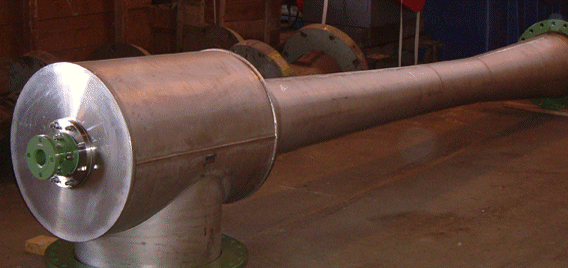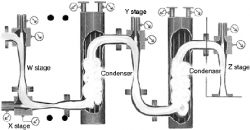Chemical and Process Engineering Resources

Steam jet ejectors offer a simple, reliable means of producing vacuum, and have a low installed cost as well. They are commonly found in process plants having available steam. The vacuum produced is useful for many processes, including evaporation, cooling, hydration, crystallization, deaeration and filtration.
Through the simplicity of its construction (Figure 1), the steam-jet ejector provides many years of troublefree operation.
For example, a loss of vacuum in a multistage ejector system might have many plant personnel disassembling the first-stage ejector booster, on the assumption that one must check a unit from inlet to outlet. In fact (as will be shown later in this article), this is the last place to look. Fortunately, downtime can be kept to a minimum when a logical sequence of steps -- a checklist -- is followed to locate the source of trouble.
 Ejector Basics
Ejectors can be classified as single-stage or multistage. Multistage ejectors may be further divided into condensing or noncondensing types. The single-stage ejector, the simplest and most common type, is generally recommended for pressures ranging from atmospheric pressure (30 in. Hg absolute) to 3 in. Hg abs. Discharge is typically at or near atmospheric pressure. The boxed section of Figure 1 shows a single-stage system. The effects of injected steam on process vapors is shown in figure 4. Multistage noncondensing ejectors (MNEs) are used to produce suction pressures lower than 3 or 4 in. Hg abs. Steam consumption in an MNE is relatively high. Each successive stage is required to handle the load plus the motive steam from the previous stage. MNEs are frequently used when low first cost is more important than long-range economy. They are also used for intermittent service or when condensing water is not available. MNEs are usually two-stage, although six-stage units have been used successfully.
Multistage condensing ejectors (MCEs) are available in two through six stages. Intercondensers (surface or direct-contact) between stages condense steam from the preceding stage, reducing the load to be compressed in the succeeding stage. A multistage system is shown in Figure 1.
Four-, five- and six-stage ejectors are used to achieve suction pressures as low as 5 µm Hg abs. Under such vacuum conditions, pressure between the preliminary stages is too low to permit condensation of ejector steam, and only the final two stages are fitted with condensers. MCEs remove condensable vapor ahead of a given ejector stage. They also permit use of a smaller ejector, and a reduction in the amount of steam required. Condenser nomenclature is determined by the corresponding operating conditions and functions.
Precondensers are used when the absolute pressure of the process is sufficiently high to allow condensation at the temperature of the available water supply. Noncondensables are removed from the precondenser by one or more ejector stages. Condensers or inter-condensers liquefy process vapor and motive steam from one or more preceding booster ejectors. Aftercondensers condense steam discharging from the last-stage ejector, generally at atmospheric pressures.
There are two basic types of condensers -- direct-contact and surface-contact. In direct-contact (countercurrent, barometric design) condensers, cooling water is mixed directly with the vapor to be condensed, then discharged to atmosphere through a barometric leg or tailpipe of sufficient length to overcome the atmospheric pressure. A means of cleaning up or otherwise disposing the water that has become contaminated by process material is often required. The surface-contact condenser permits main-condenser cooling water to be used as cooling water through inter- and aftercondensers, for energy and process-water conservation.

 FB
FB


3 Comments
Excellent Article !
very informative article.. thnx
Additional information on the <air to steam mass ratio> for each pressure level or for a certain compression ratio would be greatly appreciated. There might be any calculation tool available on this subject, isn't it?
Tanks in advance.